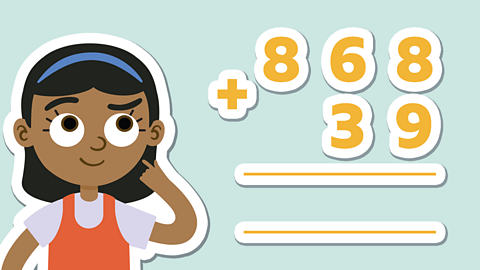What is column subtraction?
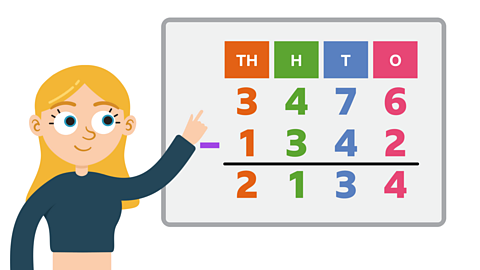
When you subtract using large numbers, it's often better to use a written method.
Column subtraction is a good written method to take one number away from another. It involves writing the smaller number beneath the larger, so that the digits line up for each place value.
You then subtract the digits, starting from the ones column on the right-hand side.
First subtract the ones, then the tens, then the hundreds, then the thousands.

Quiz: Subtracting with 4 digits or more
Complete this quiz to better understand how to subtract with 4 digits or more.
Subtraction with exchange
When you use the column method to subtract two numbers, the larger number goes above the smaller number. You then subtract digits from each column, starting with the ones.
Sometimes a digit from the second number is larger than the digit in the first number. This means it cannot be directly subtracted. You need to exchange a digit from the next column and rename.
Remember, 10 ones is equivalent to 1 ten, 10 tens is equivalent to 1 hundred and 10 hundreds is equivalent to 1 thousand. You need to understand and use this when you exchange and rename numbers when needed.
Take a look at how to work out this subtraction:
4328 − 1436 = ?
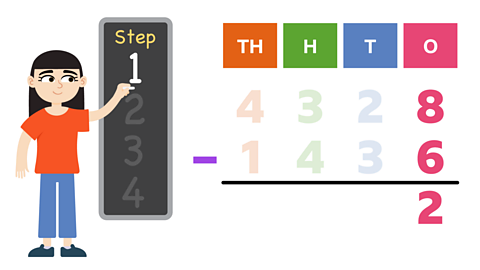
Image caption, Start with the ones column and subtract the two numbers. 8 − 6 = 2
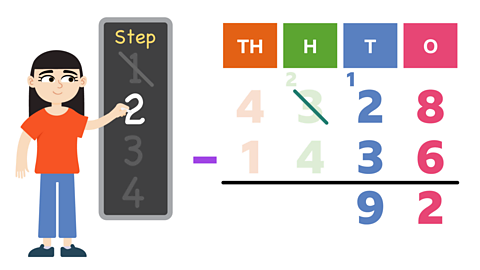
Image caption, Move on to the tens column. You need to exchange from the hundreds column, since you cannot subtract 3 tens from 2 tens. Once you have exchanged, you now have 12 tens take away 3 tens. 12 − 3 = 9
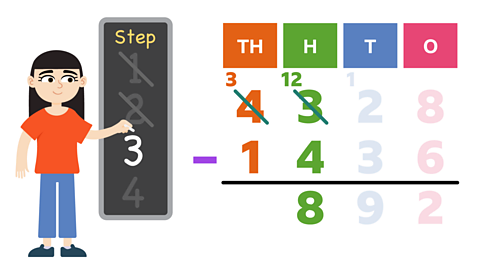
Image caption, Now move onto the hundreds column. You need to exchange again from the thousands column and rename the hundreds. The subtraction becomes 12 hundreds take away 4 hundreds. 12 − 4 = 8
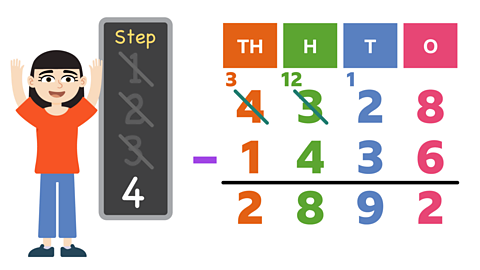
Image caption, Finally, subtract in the thousands column. 3 thousand take away 1 thousand. 3 − 1 = 2. Then you have your final answer. 4328 − 1436 = 2892
1 of 4
Subtraction with larger numbers
If you can subtract two 4-digit numbers from each other, then you can use the same method to subtract using larger numbers.
You use the same method no matter how many digits are in the numbers.
Take a look at how to work out this subtraction:
12328 − 3167 = ?

Image caption, Start from the ones column. 8 − 7 = 1
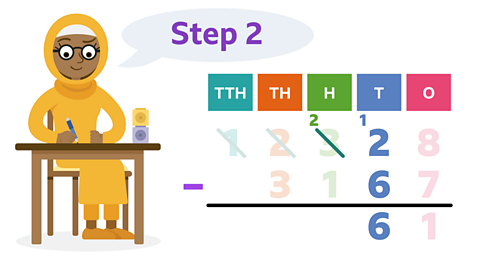
Image caption, Move on to the tens column. You need to exchange a hundred from three hundred, since you cannot subtract 6 tens from 2 tens. Once you have exchanged, you now have 12 tens take away 6 tens. 120 − 60 = 60
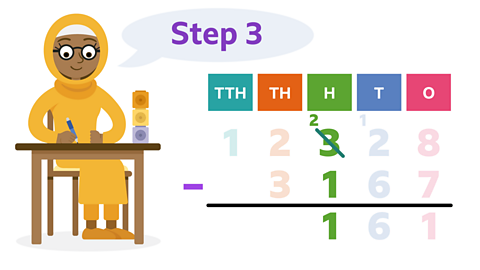
Image caption, Now move onto the hundreds column. The subtraction is 2 hundreds take away 1 hundred. 200 − 100 = 100
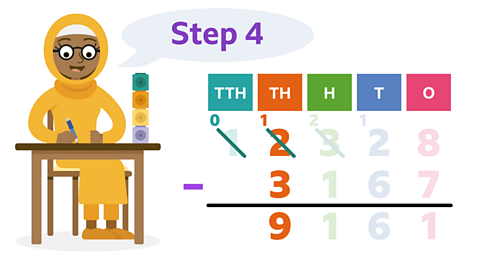
Image caption, In the thousands column, you cannot subtract 3 thousands from 2 thousands. You need to exchange again from the tens of thousands column. The subtraction becomes 12 thousands take away 3 thousands. 12,000 − 3,000 = 9,000
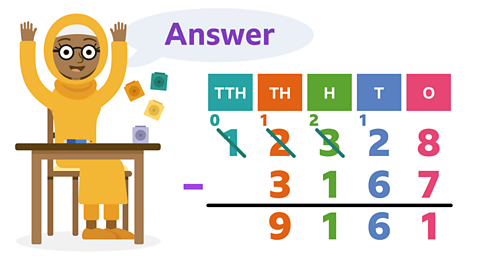
Image caption, Then you have your final answer. 12328 − 3167 = 9161
1 of 5
Example
Kevin has worked out the difference between 34,256 and 12,382.
This is his calculation:
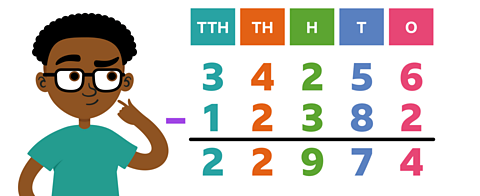
Is Kevin correct?
34256 − 12382 = 22974
✓ No. The answer is 21,874.
Kevin answered 22,974. Lets work out why he is wrong and find the right answer.

Image caption, Start with the ones column. 6 − 2 = 4

Image caption, In the tens column, you can’t subtract 80 from 50, so you need to exchange a hundred. This makes 150 − 80 = 70. Remember to reduce the number of hundreds after you have exchanged.
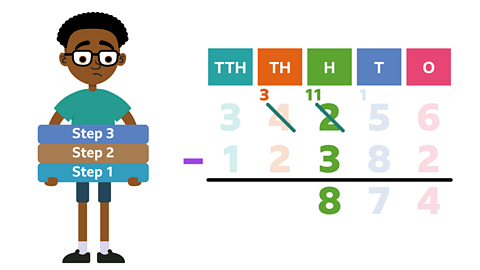
Image caption, In the hundreds column, you can't subtract 300 from 100, so you exchange a thousand to make 11 hundreds. 1100 − 300 = 800
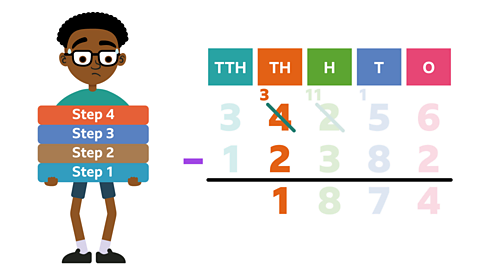
Image caption, Next look at the thousands column. 3000 − 2000 = 1000
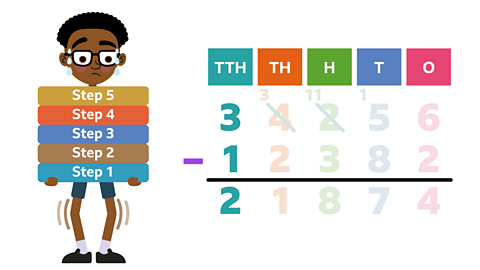
Image caption, Finally look at the tens of thousands column. 30000 − 10000 = 20000
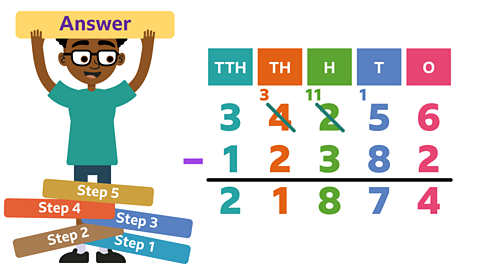
Image caption, The final calculation shows that 34256 − 12382 = 21874
1 of 6
Always take your time when you are working out column subtraction.
Make sure you remember all the steps and exchange when you need to.
Play our fun maths game Guardians: Defenders of Mathematica. gamePlay our fun maths game Guardians: Defenders of Mathematica
Use your times tables and more maths skills to defeat monsters and reclaim the Kingdom of Mathematica

More on Adding and subtracting
Find out more by working through a topic
- count1 of 12
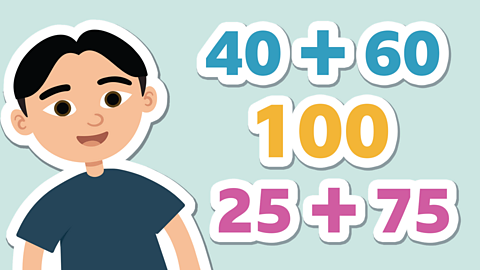
- count2 of 12

- count3 of 12

- count4 of 12
